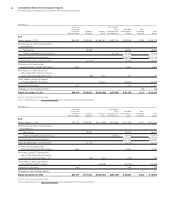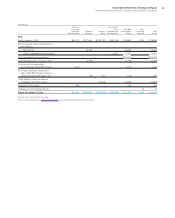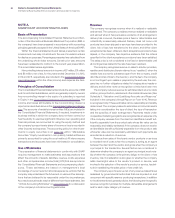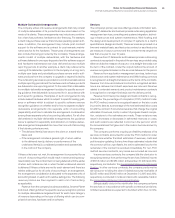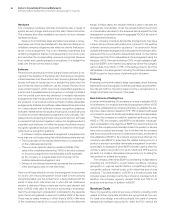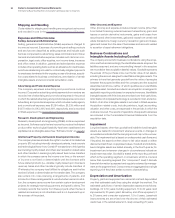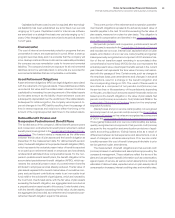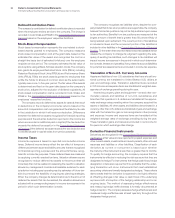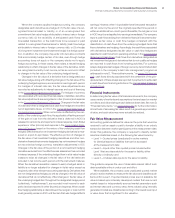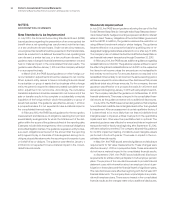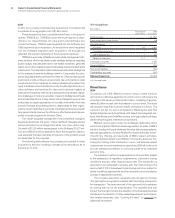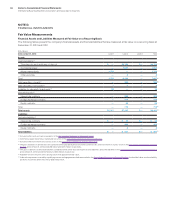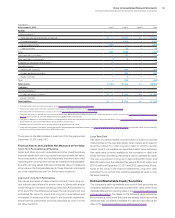IBM 2013 Annual Report Download - page 92
Download and view the complete annual report
Please find page 92 of the 2013 IBM annual report below. You can navigate through the pages in the report by either clicking on the pages listed below, or by using the keyword search tool below to find specific information within the annual report.
Notes to Consolidated Financial Statements
International Business Machines Corporation and Subsidiary Companies
91
Where the company applies hedge accounting, the company
designates each derivative as a hedge of: (1) the fair value of a rec-
ognized financial asset or liability, or of an unrecognized firm
commitment (fair value hedge attributable to interest rate or foreign
currency risk); (2) the variability of anticipated cash flows of a
forecasted transaction, or the cash flows to be received or paid
related to a recognized financial asset or liability (cash flow hedge
attributable to interest rate or foreign currency risk); or (3) a hedge
of a long-term investment (net investment hedge) in a foreign opera-
tion. In addition, the company may enter into derivative contracts
that economically hedge certain of its risks, even though hedge
accounting does not apply or the company elects not to apply
hedge accounting. In these cases, there exists a natural hedging
relationship in which changes in the fair value of the derivative, which
are recognized currently in net income, act as an economic offset
to changes in the fair value of the underlying hedged item(s).
Changes in the fair value of a derivative that is designated as a
fair value hedge, along with offsetting changes in the fair value of the
underlying hedged exposure, are recorded in earnings each period.
For hedges of interest rate risk, the fair value adjustments are
recorded as adjustments to interest expense and cost of financing
in the Consolidated Statement of Earnings. For hedges of currency
risk associated with recorded financial assets or liabilities, derivative
fair value adjustments are recognized in other (income) and expense
in the Consolidated Statement of Earnings. Changes in the fair value
of a derivative that is designated as a cash flow hedge are recorded,
net of applicable taxes, in OCI, in the Consolidated Statement of
Comprehensive Income. When net income is affected by the vari-
ability of the underlying cash flow, the applicable offsetting amount
of the gain or loss from the derivative that is deferred in AOCI is
released to net income and reported in interest expense, Cost, SG&A
expense or other (income) and expense in the Consolidated State-
ment of Earnings based on the nature of the underlying cash flow
hedged. Effectiveness for net investment hedging derivatives is mea-
sured on a spot-to-spot basis. The effective portion of changes in
the fair value of net investment hedging derivatives and other non-
derivative financial instruments designated as net investment hedges
are recorded as foreign currency translation adjustments in OCI.
Changes in the fair value of the portion of a net investment hedging
derivative excluded from the effectiveness assessment are recorded
in interest expense. If the underlying hedged item in a fair value hedge
ceases to exist, all changes in the fair value of the derivative are
included in net income each period until the instrument matures.
When the derivative transaction ceases to exist, a hedged asset or
liability is no longer adjusted for changes in its fair value except as
required under other relevant accounting standards. Derivatives that
are not designated as hedges, as well as changes in the fair value of
derivatives that do not effectively offset changes in the fair value of
the underlying hedged item throughout the designated hedge period
(collectively, “ineffectiveness”), are recorded in net income for each
period and are reported in other (income) and expense. When a cash
flow hedging relationship is discontinued, the net gain or loss in AOCI
must generally remain in AOCI until the item that was hedged affects
earnings. However, when it is probable that a forecasted transaction
will not occur by the end of the originally specified time period or
within an additional two-month period thereafter, the net gain or loss
in AOCI must be reclassified into earnings immediately. The company
reports cash flows arising from derivative financial instruments des-
ignated as fair value or cash flow hedges consistent with the
classification of cash flows from the underlying hedged items that
these derivatives are hedging. Accordingly, the cash flows associated
with derivatives designated as fair value or cash flow hedges are
classified in cash flows from operating activities in the Consolidated
Statement of Cash Flows. Cash flows from derivatives designated as
net investment hedges and derivatives that do not qualify as hedges
are reported in cash flows from investing activities. For currency
swaps designated as hedges of foreign currency denominated debt
(included in the company’s debt risk management program as
addressed in note D, “Financial Instruments,” on pages 102 through
106), cash flows directly associated with the settlement of the prin-
cipal element of these swaps are reported in payments to settle debt
in cash flows from financing activities in the Consolidated Statement
of Cash Flows.
Financial Instruments
In determining the fair value of its financial instruments, the company
uses a variety of methods and assumptions that are based on market
conditions and risks existing at each balance sheet date. See note D,
“Financial Instruments,” on pages 100 to 102 for further information.
All methods of assessing fair value result in a general approximation
of value, and such value may never actually be realized.
Fair Value Measurement
Accounting guidance defines fair value as the price that would be
received to sell an asset or paid to transfer a liability in an orderly
transaction between market participants at the measurement date.
Under this guidance, the company is required to classify certain
assets and liabilities based on the following fair value hierarchy:
• Level 1—Quoted prices (unadjusted) in active markets
for identical assets or liabilities that can be accessed
at the measurement date;
• Level 2—Inputs other than quoted prices included within
Level 1 that are observable for the asset or liability, either
directly or indirectly; and
• Level 3—Unobservable inputs for the asset or liability.
The guidance requires the use of observable market data if such
data is available without undue cost and effort.
When available, the company uses unadjusted quoted market
prices in active markets to measure the fair value and classifies such
items within Level 1. If quoted market prices are not available, fair
value is based upon internally developed models that use current
market-based or independently sourced market parameters such
as interest rates and currency rates. Items valued using internally
generated models are classified according to the lowest level input
or value driver that is significant to the valuation.



